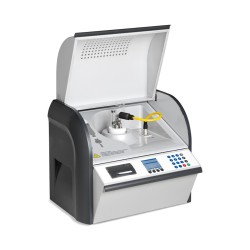
|
Feature |
DPA 75 C ACCU |
DTA 100 C |
DTL C |
|
Type |
Oil Breakdown Voltage Tester |
Oil Breakdown Voltage Tester |
Dissipation Factor Oil Tester |
|
Key Functionality |
Measures breakdown voltage of transformer oil |
Measures breakdown voltage of transformer oil with automated processes |
Measures dissipation factor (tan δ) of transformer oil, indicating oil quality and contamination |
|
Power Source |
Rechargeable battery-powered (ACCU) |
Mains-powered |
Mains-powered |
|
Testing Standards |
IEC 60156, ASTM D1816, ASTM D877 and more |
IEC 60156, ASTM D1816, ASTM D877 and mor |
IEC 60247, VDE 0380-2:2005_01 BS 5737:1979 and more |
|
Measurement Range |
Up to 75 kV |
Up to 100 kV |
Dissipation factor and relative permittivity measurements |
|
Display and Interface |
High-resolution touch display; user-friendly operation |
High-resolution touch display; automated testing protocols |
High-resolution touch display; dedicated to dissipation factor measurements |
|
Automation Features |
Automatic testing sequences; customizable test parameters |
Fully automated testing; robust data analysis and export functions |
Semi-automated for dissipation factor testing |
|
Portability |
High portability due to battery operation; suitable for on-site testing |
Designed for laboratory and high-throughput testing |
Designed for laboratory use |
|
Data Export and Analysis |
USB and PC connectivity; detailed report generation |
USB and PC connectivity; advanced analytics and comprehensive report generation |
USB and PC connectivity; focused on dissipation factor trends |
|
Application Focus |
Mobile testing in the field; robust for varied environments |
High-volume laboratory testing; suitable for precise, repeatable measurements |
In-depth analysis of oil insulation properties in laboratory settings |
|
Unique Features |
Battery operation; excellent for remote locations |
High voltage range (100 kV); exceptional automation for breakdown testing |
Specialized in dissipation factor measurement; provides precise insights into dielectric loss |
|
Typical Users |
Field engineers, maintenance teams |
Laboratory technicians, transformer testing professionals |
Oil analysis specialists, laboratory engineers |